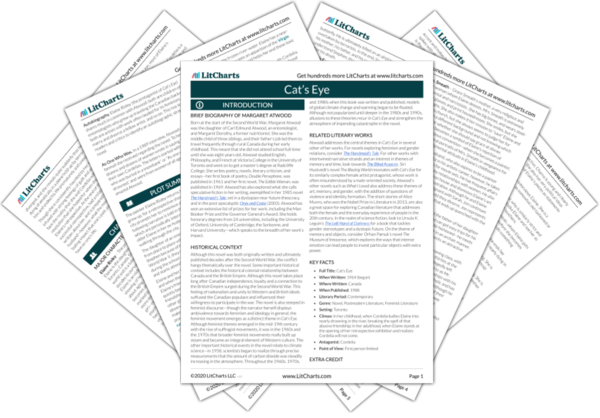As a child, Elaine has to walk to school past a ravine with a wooden bridge over it—which becomes a complex symbol of transition, uncertainty, and imagination. There are rumors of dangerous men who lurk to attack young women in that ravine, so Elaine and her friends aren’t supposed to ever stray from the bridge. The bridge, then, represents hidden dangers and the perverse ways that some people use public spaces in order to make targets—it is a space of vulnerability, uncertainty, and darkness. It’s also a space that marks the divide between the sexes: men wander freely, making young women unsafe.
The bridge also becomes the subject of several mysteries. First, Elaine’s brother Stephen buries his collection of marbles somewhere out by the bridge. Later, Cordelia tries to convince Elaine, Carol, and Grace that dead people populate the water beneath it because the river runs from a cemetery. After that, she throws Elaine’s hat down into the “ravine where the bad men are” in winter and forces her to fetch it, which leads Elaine to nearly freeze to death until she thinks she sees an apparition of the Virgin Mary. Even when these mysteries are debunked, they captivate Elaine’s imagination. Her own mother collects plants down by the ravine, and Elaine knows the Virgin Mary apparition was just wishful thinking; no one came to help her. This shows the ambivalence of the bridge space—it takes on at once the darkest and most hopeful rumors, some of which prove true—a young woman is killed by the river during Elaine’s high school years—and others of which fade away.
Bridges also represent duality and transition—they link a starting point and an end point, creating a sense of uncertainty and ambivalence. When one stands on the bridge, one is no longer on solid ground. This is especially evident in Elaine’s painting Falling Women, which depicts three women falling off the bridge. This work further underscores that not only do bridges stretch between two horizontal points, but they also mark the dimension between the high and the low—and call into question what might be lurking underneath a simple surface. Elaine again works the bridge into her painting Unified Field Theory, this time with a galaxy of marbles buried underneath it. The bridge exists as a space of intense romantic imagination as well as deep fear.
The wooden bridge of Elaine’s youth eventually gets torn down, and Elaine watches it with “an uneasy feeling, as if something’s buried down there, a nameless, crucial thing” or as though there were “someone still on the bridge, left by mistake, up in the air…” Years later, she walks across the concrete bridge that has replaced it and thinks, “Nevertheless it’s the same bridge.” As a symbol, it does not matter if years pass or the bridge changes in form—it stands regardless for a period of suspension between two extremes, the potential fear of falling, and the uncertainty about whether danger or beauty lurks beneath the surface.
The Bridge Quotes in Cat’s Eye
This is the middle of my life. I think of it as a place, like the middle of a river, the middle of a bridge, halfway across, halfway over. I’m supposed to have accumulated things by now: possessions, responsibilities, achievements, experience and wisdom. I’m supposed to be a person of substance.
We cross the wooden bridge on the way home from school. I am walking behind the others. Through the broken boards I can see the ground below. I remember my brother burying his jar full of puries, of waterbabies and cat’s eyes, a long time ago, down there somewhere under the bridge. The jar is still there in the earth, shining in the dark, in secret. I think about myself going down there alone despite the sinister unseen men, digging up the treasure, having all that mystery in my hands. I could never find the jar, because I don’t have the map. But I like to think about things the others know nothing about.
I hear someone talking to me. […] The person who was standing on the
bridge is moving through the railing, or melting into it. It’s a
woman […] She isn’t falling, she’s coming down toward me as if walking, but
there’s nothing for her to walk on. […] Now she’s quite close. I can see the white glimmer of her face, the dark scarf or hood around her head, or is it hair? She holds out her arms to me and I feel a surge of happiness. Inside
her half-open cloak there’s a glimpse of red. It’s her heart, I
think. It must be her heart, on the outside of her body, glowing
like neon, like a coal. […] You can go home now, she says. It will be all right. […] I don’t hear the words out loud, but this is what she says.












